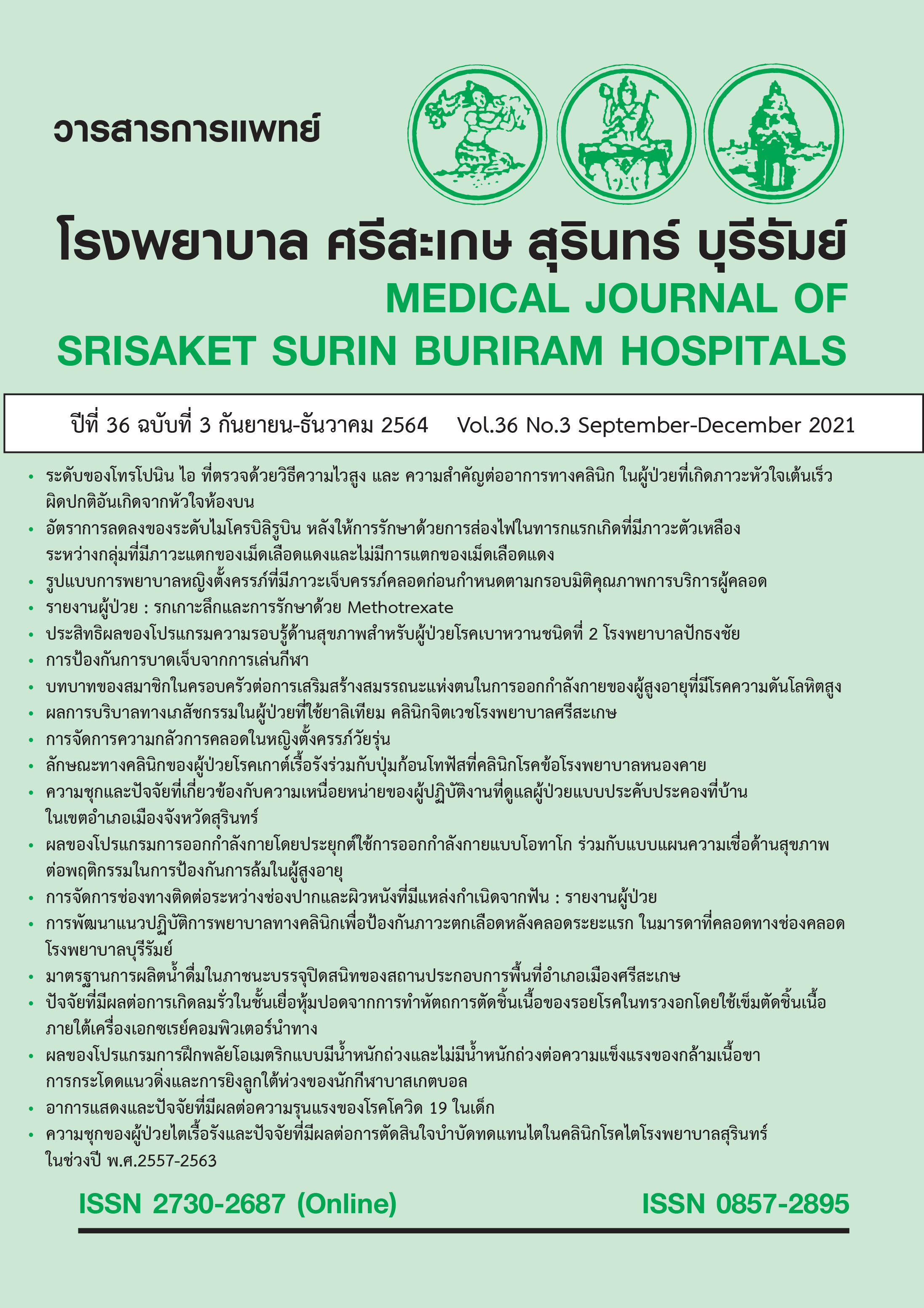ความชุกและปัจจัยที่เกี่ยวข้องกับความเหนื่อยหน่ายของผู้ปฏิบัติงานที่ดูแลผู้ป่วยแบบประคับประคองที่บ้านในเขตอำเภอเมืองสุรินทร์
Main Article Content
บทคัดย่อ
หลักการและเหตุผล: ความเหนื่อยหน่ายในผู้ปฏิบัติงานด้านการดูแลแบบประคองประคองเป็นสิ่งสำคัญและเพิ่มมากขึ้น แต่ยังไม่มีเกณฑ์ในการการวินิจฉัยความเหนื่อยหน่ายที่ชัดเจน
วัตถุประสงค์: เพื่อศึกษาความชุกและปัจจัยที่เกี่ยวข้องกับความเหนื่อยหน่ายของผู้ปฏิบัติงานที่ดูแลผู้ป่วยแบบ ประคับประคองที่บ้านในเขตอำเภอเมืองสุรินทร์
วิธีการศึกษา: การวิจัยนี้เป็นการศึกษาเชิงพรรณนาแบบสำรวจภาคตัดขวาง (descriptive cross-sectional survey) ในผู้ปฏิบัติงานด้านการดูแลแบบประคับประคองจากหน่วยปฐมภูมิ 28 ในอำเภอเมืองสุรินทร์ เครื่องมือที่ใช้คือ 1) แบบเก็บข้อมูลพื้นฐานส่วนบุคคล 2) แบบประเมินปัจจัยลักษณะสภาพแวดล้อมในการทำงานดูแลผู้ป่วยแบบประคับประคอง 3) แบบประเมินความเหนื่อยหน่ายของผู้ปฏิบัติงานด้านการดูแลแบบประคับประคอง (MBI) วิเคราะห์ข้อมูลโดยใช้สถิติเชิงพรรณนาได้แก่ ความถี่, ค่าร้อยละ, ค่าเฉลี่ย, ส่วนเบี่ยงเบนมาตรฐาน และใช้สถิติเชิงวิเคราะห์ ได้แก่ chi-square โดยกำหนดค่านัยสำคัญทางสถิติที่ p<0.05
ผลการศึกษา: กลุ่มตัวอย่างผู้ปฏิบัติด้านการดูแลแบบประคับประคองจำนวน 102 ราย ส่วนใหญ่เป็นเพศหญิง 81 ราย (ร้อยละ 79.4) มีอายุเฉลี่ย 42 ปี มีอาชีพพยาบาล 65 ราย (ร้อยละ 63.7) ความชุกของความเหนื่อยหน่ายเป็นร้อยละ 61.8 เมื่อจำแนกตามกลุ่มอาชีพพบว่า พยาบาลมีความเหนื่อยหน่ายสูงสุด ร้อยละ 63.5 นักวิชาการสาธารณสุขร้อยละ 19 เจ้าพนักงานสาธารณสุขร้อยละ 9.5 และแพทย์ร้อยละ 7.9 ตามลำดับ และปัจจัยที่มีความสัมพันธ์กับความเหนื่อยหน่ายอย่างมีนัยสำคัญทางสถิติ คือ เพศ (p=0.042) ระดับการศึกษา (p=0.021) จำนวนครั้งที่ไปเยี่ยมผู้ป่วยที่ต้องดูแลแบบประคับประคอง (p=0.035) ลักษณะงานที่รับผิดชอบ (p=0.015) การรับรู้ต่อความสามารถเชิงวิชาชีพ (p=0.015)
สรุป: ความชุกของความเหนื่อยหน่ายในผู้ปฏิบัติงานด้านการดูแลแบบประคับประคองในเขตอำเภอเมืองสุรินทร์ พบได้ 3 ใน 5 ของกลุ่มตัวอย่างผู้ปฏิบัติงานด้านการดูแลแบบประคับประคอง เมื่อจำแนกตามกลุ่มอาชีพพบว่า พยาบาลมีความชุกของความเหนื่อยหน่ายสูงสุด รองลงมาได้แก่นักวิชาการสาธารณสุข เจ้าพนักงานสาธารณสุข และแพทย์ตามลำดับ ส่วนปัจจัยที่มีความสัมพันธ์กับความเหนื่อยหน่ายในผู้ปฎิบัติงานด้านการดูแลแบบประคับประคองอย่างมีนัยสำคัญทางสถิติ คือ เพศ การศึกษา จำนวนครั้งที่ไปเยี่ยมผู้ป่วยที่ต้องดูแลแบบประคับประคอง ลักษณะงานที่รับผิดชอบ และการรับรู้ต่อความสามารถเชิงวิชาชีพ
คำสำคัญ: ความเหนื่อยหน่าย ผู้ปฏิบัติงานด้านการดูแลแบบประคับประคอง แบบประเมินความเหนื่อยหน่าย (MBI)
Article Details

อนุญาตภายใต้เงื่อนไข Creative Commons Attribution-NonCommercial-NoDerivatives 4.0 International License.
เอกสารอ้างอิง
World health organization. Palliative Care. [Internet]. 2020. [cited 2021 May 3]. Available from:URL:https://www.who.int/news-room/fact-sheets/detail/palliative-care.
Pereira MS, Teixeira CM,Ribeiro O, Marrero PH, Fonseca AM,CarvalhoAS.Burnout in physicians and nurses: a multicentre quantitative study in palliative care units in Portugal. Referência. 2014;3:55-64. doi: 10.12707/RIII131783
Pavelková H, BužgováR.Burnout among healthcare workers in hospice care.Central European Journal of Nursing and Midwifery. 2015;6(1):218-223. Cent Eur J Nurs Midw 2015;6(1):218–223 doi: 10.15452/CEJNM.2015.06.0006
Koh MY, Chong PH, Neo PS, Ong YJ, Yong WC, Ong WY,et al. Burnout, psychological morbidity and use of coping mechanisms among palliative care practitioners: A multi-centre cross-sectional study. Palliat Med 2015;29(7):633-42. doi: 10.1177/0269216315575850.
บุญเอื้อ โจว. ปัจจัยที่มีอิทธิพลต่อความเหนื่อยหน่ายในการทํางานของพยาบาลวิชาชีพ: ศึกษากรณีวิทยาลัยแพทยศาสตร์ กรุงเทพมหานครและวชิรพยาบาล. [ปริญญานิพนธ์ ศิลปศาสตรมหาบัณฑิต(พัฒนาสังคม)]. คณะพัฒนาสังคมและสิ่งแวดล้อม, บัณฑิตวิทยาลัย; กรุงเทพฯ : สถาบันบัณฑิตพัฒนบริหารศาสตร์; 2553.
ศรัณย์ ศรีคำ,วิโรจน์ เจียมจรัสรังษี, เดชา ลลิตอนันต์พงษ์. ภาวะเหนื่อยล้าในการทำงานและปัจจัยที่เกี่ยวข้องของแพทย์ประจำบ้านโรงพยาบาลจุฬาลงกรณ์. วารสารสมาคมจิตแพทย์แห่งประเทศไทย 2557;59(2):139-50.
Li H, Zuo M, Gelb AW, Zhang B, Zhao X, Yao D, et al. Chinese Anesthesiologists Have High Burnout and Low Job Satisfaction: A Cross-Sectional Survey. Anesth Analg 2018;126(3):1004-12. doi: 10.1213/ANE.0000000000002776.
Kamal AH, Bull JH, Wolf SP, Swetz KM, Shanafelt TD, Ast K, et al. Prevalence and Predictors of Burnout Among Hospice and Palliative Care Clinicians in the U.S. J Pain Symptom Manage 2016;51(4):690-696. doi: 10.1016/j.jpainsymman.2015.10.020.
Parola V, Coelho A, Cardoso D, Sandgren A, Apóstolo J. Prevalence of burnout in health professionals working in palliative care: a systematic review. JBI Database System Rev Implement Rep. 2017 Jul;15(7):1905-33. doi: 10.11124/JBISRIR-2016-003309.JBI Database System Rev Implement Rep. 2017.
Gama G, Barbosa F, Vieira M. Personal determinants of nurses' burnout in end of life care. Eur J Oncol Nurs 2014;18(5):527-33. doi: 10.1016/j.ejon.2014.04.005.
Dyrbye LN, Shanafelt TD, Sinsky CA, Cipriano PF, Bhatt J, Ommaya A, et al. Burnout among health care professionals: a call to explore and address this underrecognized threat to safe, high-quality care. [Internet]. 2017. [cited 2021 May 3]. Available from:URL:https://www.ama-assn.org/sites/ama-assn.org/files/corp/media-browser/public/ipp/i17-ipps-lotte-dyrbye-burnout-among-health-care-professionals.pdf.
Leiter MP. Coping patterns as predictors of burnout: the function of control and escapist coping patterns.J Organ Behav 2006;12:123-44.
West CP, Dyrbye LN, Shanafelt TD. Physician burnout: contributors, consequences and solutions. J Intern Med 2018;283(6):516-29. doi: 10.1111/joim.12752.
Maslach C, Jackson SE, Leiter MP. Maslach Burnout Inventory Manual. 3rd. ed. Palo Alto, CA : Consult Psychol Press; 1996.
Wu H, Liu L, Wang Y, Gao F, Zhao X, Wang L. Factors associated with burnout among Chinese hospital doctors: a cross-sectional study. BMC Public Health 2013;13:786. doi: 10.1186/1471-2458-13-786.
Fernando BMS, Samaranayake DL. Burnout among postgraduate doctors in Colombo: prevalence, associated factors and association with self-reported patient care. BMC Med Educ 2019;19(1):373. doi: 10.1186/s12909-019-1810-9.
Wong KP, Kaliya-Perumal AK, Oh J. Orthopaedic Resident Burnout: A Literature Review on Vulnerability, Risk Factors, Consequences and Management Strategies. Malays Orthop J 2019;13(2):15-19. doi: 10.5704/MOJ.1907.003.
Chatlaong T, Pitanupong J, Wiwattanaworaset P. Sleep Quality and Burnout Syndrome among Residents in Training at the Faculty of Medicine, Prince of Songkla University. SJR 2020;72(4):307-14. doi: https://doi.org/10.33192/Smj.2020.41
ศิวัช ธำรงวิศว, จารุรินทร์ ปิตานุพงศ์, วิศรุต ศรีสินทร์.ความเหนื่อยล้าจากการทำงาน และปัจจัยที่เกี่ยวข้องในพยาบาลวิชาชีพ โรง พยาบาลสงขลานครินทร์. เวชสารแพทย์ทหารบก 2019;72(3):177-85.
Sammawart S. Burnout among nurses in Ramathibodi Hospital [thesis Master Science]. Graduate School, Nursing Master. Bangkok: Mahidol University; 1989.
Maslach C, Schaufeli WB, Leiter MP. Job burnout. Annu Rev Psychol 2001;52:397-422. doi: 10.1146/annurev.psych.52.1.397.
Leiter MP, Maslach C. Areas of worklife: A structured approach to organizational predictors of job burnout. In: Emotional and physiological processes and positive intervention strategies. Bingley : Emerald Group Publishing Limited; 2003: 91-134.
Patel RS, Bachu R, Adikey A, Malik M, Shah M. Factors Related to Physician Burnout and Its Consequences: A Review. Behav Sci (Basel) 2018;8(11):98. doi: 10.3390/bs8110098.
Shanafelt TD, Dyrbye LN, Sinsky C, Hasan O, Satele D, Sloan J, et al. Relationship Between Clerical Burden and Characteristics of the Electronic Environment With Physician Burnout and Professional Satisfaction. Mayo Clin Proc 2016;91(7):836-48. doi: 10.1016/j.mayocp.2016.05.007.
Bakker AB, Westman M, Schaufeli WB. Crossover of burnout: an experimental design. Eur J Work Organ 2007;16(2):220-39.


